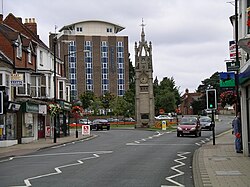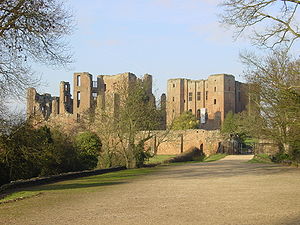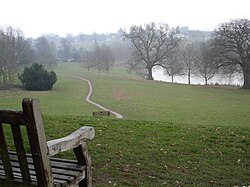Kenilworth
| Kenilworth | |
| Warwickshire | |
|---|---|
 Kenilworth Clock on Warwick Road | |
| Location | |
| Grid reference: | SP2971 |
| Location: | 52°20’28"N, 1°33’58"W |
| Data | |
| Population: | 22,582 (2001) |
| Post town: | Kenilworth |
| Postcode: | CV8 |
| Dialling code: | 01926 |
| Local Government | |
| Council: | Warwick |
| Parliamentary constituency: |
Kenilworth and Southam |
| Website: | Kenilworth The Best Kept Secret in Warwickshire |
Kenilworth is a town in Warwickshire, found about 5½ miles southwest of Coventry and 4 miles north of Warwick. The town is on Finham Brook, a tributary of the River Sowe, which joins the River Avon about 2 miles east of the centre of the town. The 2001 Census recorded a parish population of 23,219.
Modern Kenilworth is frequently regarded as a dormitory town for commuters to Coventry, Birmingham and Leamington Spa. Despite its proximity to the University of Warwick on Coventry's southern outskirts, it has only a small student population of mostly postgraduate students, although many staff at the university choose to live in Kenilworth. The town has good road, rail and air links.
Kenilworth is notable for the extensive ruins of Kenilworth Castle. Other local sights include the ruins of Kenilworth Abbey in Abbey Fields Park, St Nicholas' Parish Church and Kenilworth Clock.
Contents
History
A settlement existed at Kenilworth by the time of the Domesday Book of 1086, which records it as Chinewrde.
Geoffrey de Clinton (d. 1134) initiated the building of an Augustinian priory in 1122,[1] at the same time as he initiated the building of Kenilworth Castle.[2] The priory was raised to the rank of abbey in 1450[1] and suppressed in the Dissolution of the Monasteries in the 1530s. Thereafter the abbey grounds next to the castle, were made common land in exchange for common land that Robert Dudley, 1st Earl of Leicester used to enlarge the castle. Only a few walls and a storage barn of the original abbey survive.
Just off Coventry Road in Kenilworth is a field called the Parliament Piece. It is traditionally said to be the site where Henry III held a Parliament in August 1266, while his troops besieged Kenilworth Castle, where the late Simon de Montfort's followers, led by Henry de Hastings, were still holding out against the king's forces. This Parliament led to the Dictum of Kenilworth: a settlement that offered the rebels a way of recovering the lands that the Crown had seized from them. One copy of the Dictum is endorsed in castris apud Kenilworth — "in the camp (or castle) at Kenilworth". Members of the public have free access to Parliament Piece, which is owned by the Open Spaces Society and leased to Warwick District Council.
Geoffrey de Clinton had a deer park created near Kenilworth.[1] In 1488 Ralph, abbot of Kenilworth Abbey had 40 acre of land near Redfern northwest of the town emparked as Duck Park,[1] which despite its name was a deer park. By about 1540 there were eight deer parks near Kenilworth.[1] Two were near Rudfen: as well as Duck Park there was a 30-acre park that was called Little Park in 1581, was owned by Robert Briscoe in 1649 and was still called Briscoe's Park in 1785.[1] One of the eight deer parks, The Chase, can still be traced. The eastern part of its park pale is about a mile west of the castle and the northern part forms the boundary between Chase Wood and the farm road and bridleway between Little Chase Farm and Warrior's Lodge Farm.
In about 1414 Henry V had le plesans en marais[3] — "The Pleasuance in the Marsh"[1] — built about half a mile west of the castle.[4] This was a timber-framed banqueting house surrounded by a moated earthwork about 600 feet by about 500 feet that 15th century kings used instead of the castle's state apartments.[4] In the 16th century Henry VIII had the banqueting house demolished[4] and the materials re-used for new timber-framed buildings inside the castle.[1] The mere was drained in 1649 but "The Pleasance" earthworks survive and are a Scheduled Monument.[3]
Elizabeth I visited Robert Dudley, 1st Earl of Leicester at Kenilworth Castle several times, the last of which was in 1575. Dudley entertained the Queen with pageants and banquets that cost some £1,000 a day, presenting diversions and pageants surpassing anything ever before seen in England.[5] These included fireworks.[6]
Warwick District Council owns and manages land across the Coventry Road at Tainter's Hill. This area of public open space was designated "for the poor of the parish" under an inclosure act in 1756 and is now registered as common land. Around this time in 1778 Kenilworth windmill was built, which was later made the town's water tower. It is now a private home, minus its sails.
In 1844 the London and Birmingham Railway opened the Coventry to Leamington Line, including Kenilworth railway station. The L&NWR had a new station built in 1883 and a new link line between Kenilworth and Berkswell in 1884 to bypass Coventry. In the latter part of the 20th century British Railways closed the link line and had it dismantled.
BR withdrew passenger services from the Coventry to Leamington Line and closed Kenilworth station in January 1965 in accordance with Beeching Report The Reshaping of British Railways. In May 1977 BR reinstated passenger services but did not reopen Kenilworth station, which fell into dereliction and was eventually demolished. In 2011 Warwick Council gave John Laing plc planning permission to build a new station,[7] which is planned to open in 2013.[8][9] In the mean time Kenilworth remains "the largest town in the country without a railway station" according to a BBC Radio 4 programme broadcast in October 2012.
The railway brought industrialists from Birmingham and Coventry who developed the residential area around the town's railway station. In the 19th century the town had some fine large mansions with landscaped gardens; these were demolished after the First World War and Second World War for housing developments. The names of these mansions still survive in the names of some roads and areas of the town. For example, Towers Close was built on the grounds of Rouncil Towers. Some large trees from their grounds still survive, including Giant Sequoias from the Moorlands and Rouncil Towers.
The town's growth occasioned the addition of a second Church of England parish church, St. John's, which is on Warwick Road in Knights Meadow. It was designed by Ewan Christian and built in 1851–52.[10] It is a Gothic Revival building with a southwest bell tower and broach spire.[10]
After 1883 the original 1844 railway station on Warwick Road was partially rebuilt at the opposite end of Station Road at the rear of the King's Arms and Castle Hotel public house and used as a café. The King's Arms was demolished in 1983 but the railway station stonework remains. An exterior copy of the King's Arms was built on the site, in 2007 the building was redeveloped as a chain restaurant. The building's distinctive pillars have been retained (but not the originals) on its Warwick Road frontage. Sir Walter Scott stayed in the King's Arms and Castle Hotel when researching his novel Kenilworth.[11]
In 1884 St Nicholas' Parish Church established a mission room in an upstairs room above the Co-Op in Park Road.[12] It attracted a congregation of 150 people and in 1885 moved to new premises.[12] In 1905 the congregation moved to new a "tin tabernacle" iron building that had been newly erected in Albion Street and consecrated as Saint Barnabas' Mission Church,[12] a daughter church of St. Nicholas'.
The railway boosted Kenilworth's market gardening. There were reputedly 40 nurseries growing market garden produce in Kenilworth but all have now been reveloped for housing. The last was Guest's Nursery, which was developed as 23 houses in 2002. The railway took the produce to London where Kenilworth tomatoes had a reputation for quality. The Victorian era saw a large expansion of the town to the west of Abbey Fields and on land around Warwick Road. Most of the buildings along Warwick Road date from this period and later but a few earlier cottages also survive.
The former mansion on Forrest Road, built around 1901, still stands. It is believed that a William Forrest bought the surrounding land, except that of the terrace to the north of Abbey End, and built the house, either for himself or for his family. The house was split into three separate residential lots in the 1970s, the main part of the house forming 'Hillcrest', the west wing of the house with the main grand staircase and gardens forming 'Max Gate', and the billiards room forming the bungalow 'South Brent'. The former landscaped gardens to the east and west of the property have been built on for residential purposes, but the south and north gardens still belong to the house. Some main features have been lost during the transition internally, but externally the house still keeps its grand bay windows, tiled walls, high chimney stacks and other features, which can be seen in the new flats, Mulberry Court on Abbey End. Warwick Road is now the main commercial centre of the town.
Most of the older existing buildings of Kenilworth are on Castle Green, New Row and High Street (formerly Alta Strata, meaning the high dry ground above the Abbey). High Street has many of the older buildings in Kenilworth, with long established shops. The age of these buildings make it appear that this is the original settlement, but in fact this is simply the oldest existing part of the town. The original settlement along the present day Warwick Road has been subject to continuous redevelopment since the 12th century and now retains few of its original buildings. Many of the houses around Castle Green are built of stone salvaged in the 17th century when the castle walls were slighted after the Civil War.
In May 1961, the Kenilworth Society was formed as a result of concerns about a group of 17th century listed cottages adjacent to the Finham Brook in Bridge Street.[13] The Society's objectives are to promote consciousness about Kenilworth's character and to encourage its preservation.
Sports
- Cricket:
- Kenilworth Wardens
- Kenilworth Cricket Club
- Cycling: Kenilworth Wheelers
- Football:
- Kenilworth Town FC
- Kenilworth Wardens FC
- Golf: Kenilworth Golf Club - a mature 18 hole parkland course, plus a small six hole par 3 course.
- Orieneering: Octavian Droobers
- Rugby: Kenilworth RFC
- Running: Kenilworth Runners
- Other sport: Kenilworth Tennis, Squash and Croquet Club
Abbey Fields Swimming Pool is in Abbey Fields in the middle of the town. It has a 25m x 10m indoor pool and an outdoor pool that is open from May to September. It is also the home of Kenilworth Swimming Club and the highly successful Kenilworth Masters Swimming Club.[14]
Castle Farm Recreation Centre has a four court badminton hall which can accommodate basketball, volleyball, netball, table tennis, short mat bowls and children's parties. The hall is available for casual use by members of the public in addition to sports clubs who have block bookings throughout the year.
Two Castles Run
The Two Castles Run began in 1983 as a fun run between Warwick Castle and Kenilworth Castle.[15] Since then it has grown into a run that attracted 3,000 entrants in 2010. The field was increased to 4,000 places from 2011. In 2010 and 2011 it had the status of the Warwickshire Amateur Athletic Association 10 Kilometre Championship. In 2012 all 4,000 places were sold with 25 hours of the event opening. The race is organised by Kenilworth Rotary Club[16] in conjunction with the Leamington Cycling and Athletic Club[17] and is held each June.[18]
Kenilworth Festival
In 2005, the Kenilworth Festival[19] was revived after a 70-year interval.[20] The first year was a big success but attendance was lower in 2006, doubts were raised about the festival's longevity[20] and no festival was held in 2007. Kenilworth Rotary Club then sponsored a revival of the festival in 2008, since when it has continued each year. In 2011 the festival lasted for a whole week including two weekends, 7 to 15 May.[21] Since 2009 Kenilworth Festival is organised by an independent group of volunteers, operating as Kenilworth Festival Ltd, a non-profit making organisation.
Outside links
| ("Wikimedia Commons" has material about Kenilworth) |
- Kenilworth The Best Kept Secret in Warwickshire — official Kenilworth town centre website
- Kenilworth Chamber of Trade
- Geograph photos of Kenilworth and surrounding area
- Kenilworth local history articles and books
- Kenilworth in the Second World War
References
- ↑ 1.0 1.1 1.2 1.3 1.4 1.5 1.6 1.7 Salzman 1951, pp. 132–143.
- ↑ http://www.english-heritage.org.uk/daysout/properties/kenilworth-castle/history-and-research/history/
- ↑ 3.0 3.1 "The Pleasance moated site". The National Heritage List for England. English Heritage. http://list.english-heritage.org.uk/resultsingle.aspx?uid=1007720. Retrieved 10 December 2011.
- ↑ 4.0 4.1 4.2 Pevsner & Wedgwood 1966, p. 325.
- ↑ Shepherd, Marc (24 December 2003). "Kenilworth (1864)". Gilbert & Sullivan Discography. http://www.cris.com/~Oakapple/gasdisc/sullchoral.htm#kenilworth.
- ↑ Langham, Robert (1580). Langham letter.
- ↑ "Planning Application WDC/10CC067". Warwickshire County Council. https://planning.warwickshire.gov.uk/swiftlg/apas/run/WPHAPPDETAIL.DisplayUrl?theApnID=WDC/10CC067. Retrieved 14 September 2011.
- ↑ "John Laing picks up NUCKLE station build contract". Transport Briefing (Acumen Intelligence Ltd). http://www.transportbriefing.co.uk/news/story?id=6077. Retrieved 14 September 2011.
- ↑ "Contracts signed to build new Kenilworth rail station". Coventry Telegraph. 24 July 2009. http://www.coventrytelegraph.net/news/south-warwickshire-news/2009/07/24/new-kenilworth-rail-station-a-step-nearer-92746-24229888/. Retrieved 14 September 2011.
- ↑ 10.0 10.1 Pevsner & Wedgwood 1966, p. 319.
- ↑ "Sir Walter Scott’s memory will live on as plaque is found". Kenilworth Weekly News. 22 October 2010. http://www.kenilworthweeklynews.co.uk/news/local/sir_walter_scott_s_memory_will_live_on_as_plaque_is_found_1_1580339/. Retrieved 13 December 2011.
- ↑ 12.0 12.1 12.2 "History of St Barnabas Church". St Nicholas & St Barnabas Churches Kenilworth. Benefice of St NIcholas & St Barnabas, Kenilworth. http://www.stnicholaskenilworth.org.uk/history_st_barnabas.htm. Retrieved 10 December 2011.
- ↑ "The Kenilworth Society". 2012-05-28. http://www.thekenilworthsociety.co.uk/.
- ↑ "Kenilworth Masters". 2012-05-28. http://www.kenilworthmasters.co.uk/.
- ↑ [1]
- ↑ Kenilworth Rotary Club
- ↑ Leamington Cycling and Athletic Club
- ↑ Two Castles Run
- ↑ Kenilworth Festival
- ↑ 20.0 20.1 "Kenilworth Festival makes comeback". Kenilworth Weekly News. 11 February 2008. http://www.kenilworthweeklynews.co.uk/news/Kenilworth-Festival-makes-comeback.3778332.jp.
- ↑ "Will the Queen come to Kenilworth?". Kenilworth Weekly News. 22 December 2008. http://www.kenilworthweeklynews.co.uk/news/Will-the-Queen-come-to.4835498.jp.
Books
- Pevsner, Nikolaus; Wedgwood, Alexandra (1966). Warwickshire. The Buildings of England. Harmondsworth: Penguin Books. pp. 317–326.
- Salzman, L.F., ed (1951). A History of the County of Warwick, Volume 6: Knightlow hundred. Victoria County History. pp. 132–143. http://www.british-history.ac.uk/report.aspx?compid=57113.


